August Monthly Instructional Guide for Students with Complex Access Needs
This month’s focus is on organizing your classroom and creating structure with rules, schedules, routines, and procedures. The content aligns with Quality Indicator II: Effective Teams and Quality Indicator III: Classroom Climate on the Rubric of Effective Practices for Students with Complex Access Needs and the Administrator Companion Document to the Rubric of Effective Practices for Rubric of Effective Practices for Students with Complex Access Needs. You will notice this month’s guide is heavy with content, but covering these items at the beginning of the school year will help you set your classroom up for success. Download or print the August Monthly Instructional Guide Checklist for your reference.
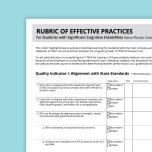
Significant Cognitive Disabilities, Behavior, Instruction, ARD/IEP Supports, Inclusion
Rubric of Effective Practices for Students with Complex Access Needs

Significant Cognitive Disabilities, ARD/IEP Supports, Instruction, Assistive Technology, Behavior, Inclusion
Administrator Companion Document to the Rubric of Effective Practices for Students with Complex Access Needs

Significant Cognitive Disabilities
August Monthly Instructional Guide Checklist
Review Resources
Start out this month by reviewing the resources you have available. These include:
- student information (educational and health records),
- classroom furniture and instructional materials,
- the Texas Essential Knowledge and Skills (TEKS) for your students’ enrolled grade levels, and
- campus, grade-level, and paraprofessional lunch/duty schedules.
Student Information
Student information is vital to setting your classroom up for success. Student educational and health records will help you identify schedule requirements, learning targets, and medical data like allergies, medications, and seizure plans. Families can also provide important information about the student, so it is best to get communication with the families started early in the school year.
Take the time to read each student’s most recent Full Individual Evaluation (FIE). This report contains important information about how the student’s disability is impacting their learning and recommendations for interventions and supports. Review each student’s current Individualized Education Program (IEP) to understand their specially designed instruction. Make notes about their goals and objectives, schedule requirements, related services, assistive technology, and other supports. Some students have a Behavior Intervention Plan (BIP) that will need to be implemented with fidelity. As you review student information, consider creating a student-at-a-glance sheet for each student.
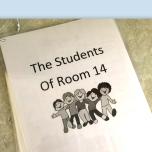
Autism, Behavior, Significant Cognitive Disabilities
Student At-A-Glance
Will any of your students be taking the State of Texas Assessments of Academic Readiness (STAAR) Alternate 2 this year? The determination for this assessment will be noted in the student’s IEP. As the state’s alternate assessment for students with the most significant cognitive disabilities, there are very specific participation requirements for eligibility. TEA has STAAR Alternate 2 Resources which include a vertical alignment and curriculum framework which will help you identify prerequisite skills to grade-level TEKS for students who may need them. We will cover the STAAR Alternate 2 in more detail in the February Monthly Instructional Guide.
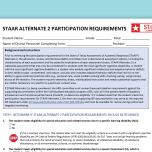
Significant Cognitive Disabilities
STAAR Alternate 2 Participation Requirements
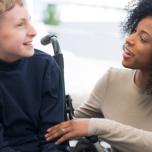
STAAR Alternate 2 Resources
A large part of your job is working as a member of students’ admission, review, and dismissal (ARD) committees to develop IEPs with the team. TEA offers guidance in the Technical Assistance: Individualized Education Program Development document and the Question and Answer document. It is important to understand how to write rigorous goals and objectives for students and monitor their progress. Use the IEP Quality and Rigor Rubric and take the free online course A Step Toward IEP Quality and Rigor from Texas SPED Support to learn more.
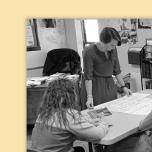
State Guidance, ARD/IEP Supports
Technical Assistance: Individualized Education Program Development
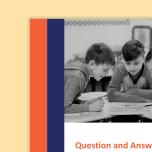
ARD/IEP Supports, State Guidance
Question and Answer: Individualized Education Program (IEP) Measurable Annual Goals

Significant Cognitive Disabilities, ARD/IEP Supports
IEP Quality and Rigor Rubric

Significant Cognitive Disabilities, ARD/IEP Supports
A Step Toward IEP Quality and Rigor for Students with Complex Access Needs
Furniture and Instructional Materials
After the summer break, you may walk into a classroom that does not quite look like a classroom yet, as it may just be a pile of furniture and boxes. Every classroom is different. What furniture and materials are available in your classroom? When organizing your classroom, consider using furniture to define spaces. This furniture can also help keep supplies stored near where they will be used during the day.
Instructional programs, classroom materials, and technology vary by campus. Is there a specific scope and sequence of instruction or a supplemental program required by your school or district? Take stock of what you have available in your classroom. Make a note of what items are required to be used or displayed and determine which items can be stored away or removed if unnecessary.
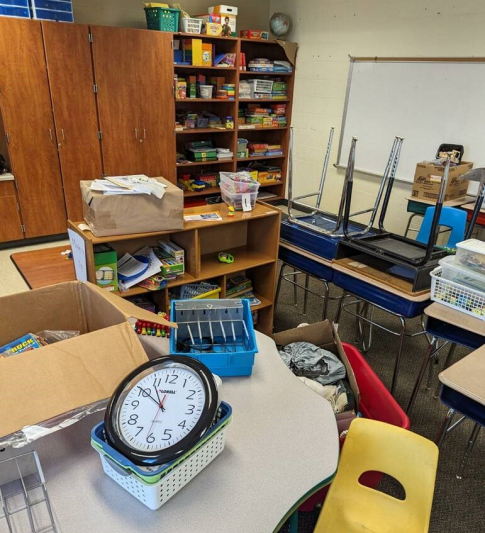
Beginning of the year classroom. Justin Morton, 2023
TEKS
The TEKS are the curriculum for all students in Texas, including students with disabilities, and contain an in-depth listing of all the knowledge and skills students enrolled in a specific grade-level or course should be learning.
- Review the enrolled-grade level TEKS for each of your students.
- Align grade-level TEKS to prerequisite skills for instruction.
- Make a note of the key concepts covered in each content area you will be responsible for.

Significant Cognitive Disabilities
TEKS
Schedules
Collect and review campus schedules, including the master schedule, lunch schedules, and duty schedules. You will use these campus resources to create daily schedules for your students and paraprofessionals.
Organize Your Classroom
After reviewing your resources, it is time to organize your classroom layout and materials. This may include:
- learning spaces,
- instructional materials, and
- documentation
Learning Spaces
Classrooms should be organized in a way that supports different types of learning experiences. For a classroom that serves students with complex access needs, this may include areas for a large group, small group, or 1:1 work with an adult; individual workstations; sensory activities; break activities; and more. Arrange your classroom so that the structure communicates what is expected to happen in each area. Keep spaces free of clutter and use purposeful visual supports.
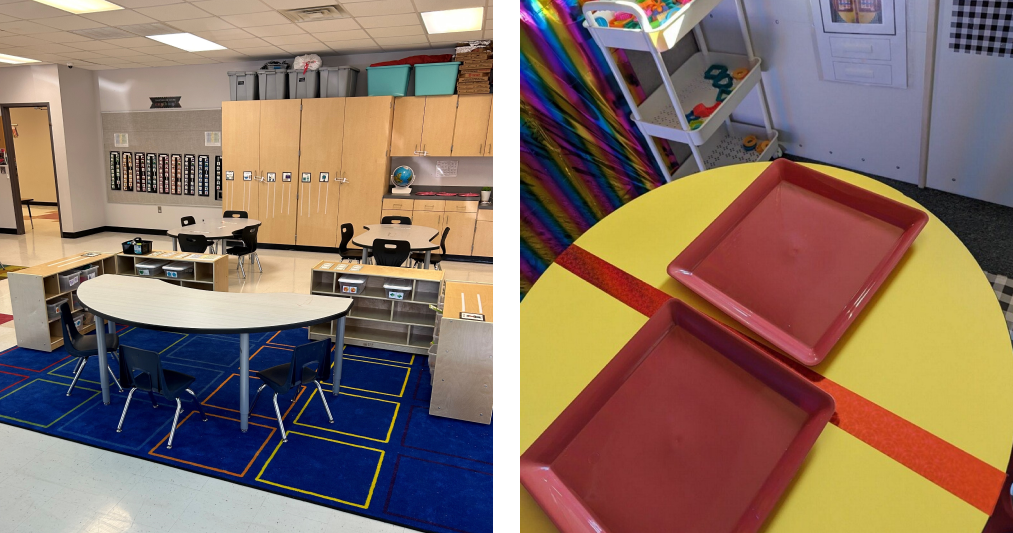
Organized classroom layout. Jennifer Singletary, 2023; Station with clear boundaries. Justin Morton, 2023
Instructional Materials
Arrange instructional materials near classroom areas where they will be used. Place any materials not currently needed out of sight in closed bins or closets to avoid cluttering learning spaces.
Consider how you will design your routines and procedures for how and when to access and appropriately use materials.
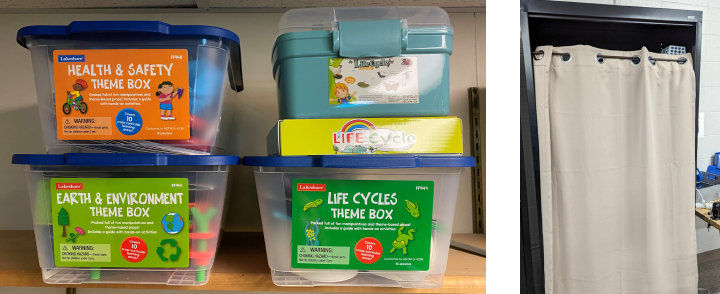
Classroom materials boxed on shelf. Shannon Beyer-Kaminski, 2023; Classroom materials covered by a curtain. Justin Morton, 2023
Documentation
Just as with other classroom materials, having clear locations for storing different types of paperwork will help maintain order. Some common types of classroom paperwork are IEPs (keep in locked file cabinets when not in use), student work, family communication, meeting agendas/notes, and data sheets.
Data sheets can be stored in binders, folders, or on clipboards, which can be easily transported and kept near the area where they will be used by staff.
Consider what procedures you need to put in place for how staff will collect data.
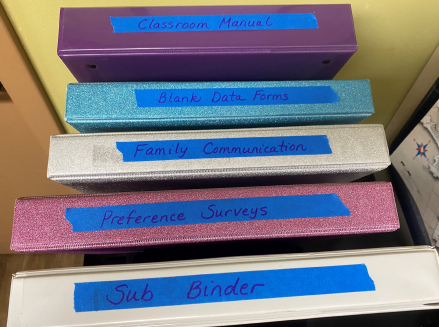
Classroom paperwork organized in binders. Shannon Beyer-Kaminski, 2023
Create Systems
Next, it is time to create structure with consistent systems. These may include:
- classroom rules,
- schedules (classroom, individual student, and staff), and
- common classroom routines and procedures.
Classroom Rules
Your classroom should have a short list of approximately three to five general rules. The class can work together to develop this list, with students contributing ideas as you guide and facilitate toward appropriate expectations.
- Decide on the rules.
- Determine consequences and reinforcements.
- Make the rules visual.

Classroom rules with photos and words. Justin Morton, 2023
Schedules
You have reviewed campus schedules, including master schedules, lunch schedules, and duty schedules. You have collected the general education classroom schedules from your students’ teachers, and you have the schedules of specially designed instruction from your students’ IEPs. Now it’s time to merge them all to into a workable schedule for your classroom. This is a complex task, but it is well worth the time and effort invested to provide students and staff with as much consistency as possible. Do not be surprised if each day looks a little different based on special classes, work duties, student therapies, and other events that do not take place daily.
Be aware that schedules may require edits for several weeks, or even months, as you collaborate with therapists and other colleagues. The campus schedules you collected may also be adjusted in the first few weeks of school and you will need to work around those changes. You may find it most helpful to make classroom, student, and staff schedules in a digital or non-static format that can be easily updated, reprinted, or rearranged to accommodate changes. You will have three main types of schedules to develop: classroom, individual student, and staff.
Starting with the classroom schedule helps you see the big picture before focusing on individual student and staff schedules. Begin by putting in all the things you know, such as paraprofessional duty schedules, or student lunches and general education times, and then fill in the rest around that framework.
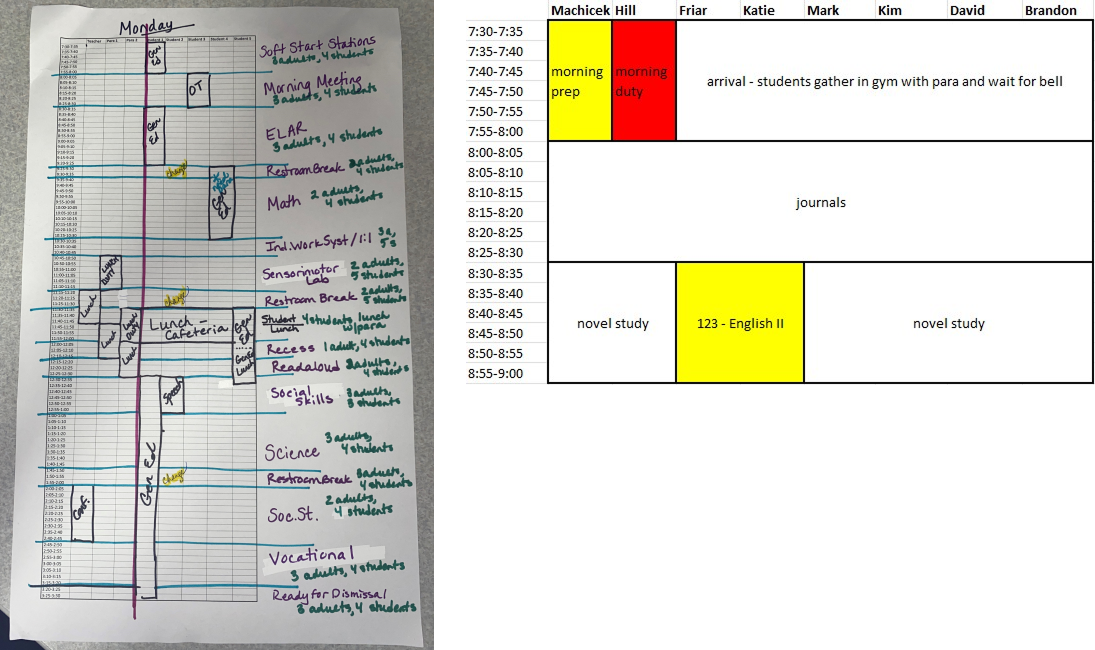
Building the classroom schedule. Shannon Beyer-Kaminski, 2023; Excerpt from secondary classroom schedule. Shannon Beyer-Kaminski, 2024
Considerations for designing classroom schedules:
- How many paraprofessionals are in your room at each time block? Remember to account for when they will be away for personal lunches and/or duty. You may want to plan more complex routines and activities for when you have more staff in the room.
- Do any students who will be leaving for general education classrooms throughout the day need assistance from your staff while they are in the other classroom? If you start to notice staffing gaps for coverage, talk to your administrator about possible solutions.
- How many students are in your room for each time block? What tolerance do those students have for work? You may need to break down your larger time blocks into smaller sections of different types of instruction.
- Do any of your students require reinforcement or sensory breaks in the classroom? How long do their breaks need to be? Are these breaks supposed to be provided upon request, or can they be worked into the schedule? If they are scheduled breaks, plan for any staff coverage needed to support these activities.
- Do your students have any personal care needs that may require staff assistance and must be worked into the schedule? Students with complex access needs might have to visit the nurse regularly for medication or require assistance with feeding or toileting.
- Where are logical places during the day to work on communication? Mark places in the schedule where your staff might pay special attention to facilitating functional and spontaneous communication.
- Where might your students’ IEP goals fit naturally into the schedule? It may be helpful to mark general concepts to remember to cover during each time block.

Significant Cognitive Disabilities
5-minute Increment Schedule Builder

Significant Cognitive Disabilities
Classroom Schedule Template

Significant Cognitive Disabilities, Instruction
Creating a Class Schedule
Individual Student Schedules
After you have developed the general classroom schedule, it is time to focus on individual student schedules. In your self-contained classroom, each student’s day may look very different from their peers’ depending on their specially designed instruction. As they learn to use the schedule, the student can more easily transition between their varying therapies and classroom routines.
Using a schedule is a skill that can be generalized into many activities in the home, school, and community. Just as your students’ days may differ, so will the type of individual schedule you create for each of them. Consider the student’s attention span, motor skills, interests/preferences, and processing abilities when customizing the schedule for the student.
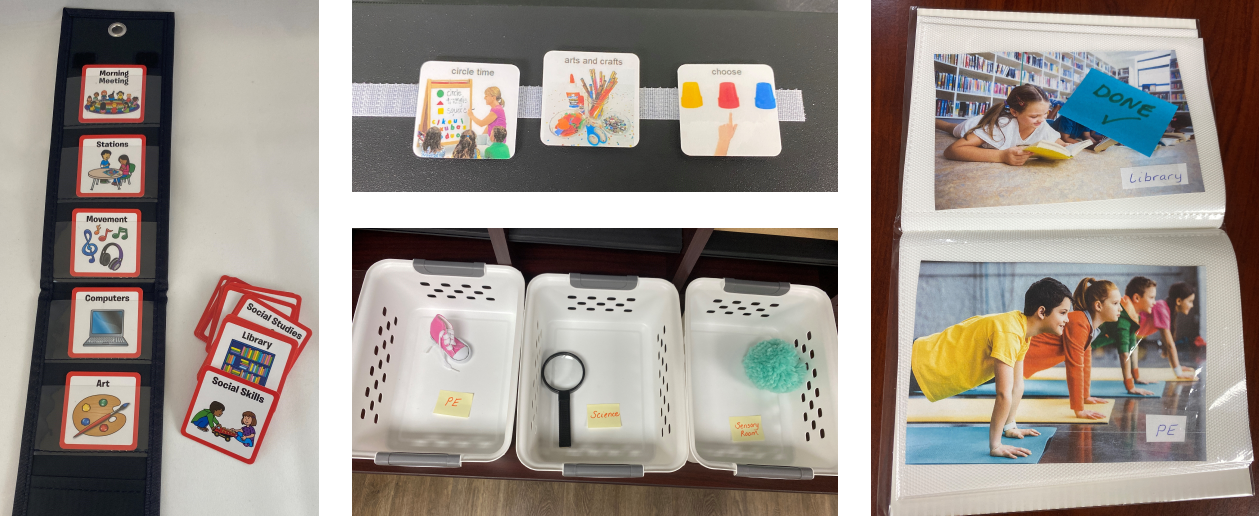
Graphic and text vertical schedule. Shannon Beyer-Kaminski, 2023; Photo and text horizontal mini schedule. Shannon Beyer-Kaminski, 2023; Object schedule. Shannon Beyer-Kaminski, 2023; Photo album schedule. Shannon Beyer-Kaminski, 2023
Staff Schedules
You’ve completed the class schedule and then worked out the students’ individual schedules. Now it’s time to create staff schedules. The schedule of each individual staff member within a classroom team will vary due to student needs and campus duties. In many classrooms, a staff member’s schedule may be slightly different for each day of the week, so having schedules clearly written and available for reference is beneficial. If you have students with complex access needs, consider rotating their support tasks amongst staff members. This helps students generalize skills across staff members and reduce the likelihood of staff burnout.
Your staff schedules let everyone know where they need to be and what they need to be doing throughout the day. What student, or students, will they be working with? In what area will they be in the classroom or building? What activity or task will they be responsible for at that time? Collaboration is key for classroom teams, so try to carve out time to meet regularly, even just briefly, to connect to other staff, share information and provide feedback on student progress.
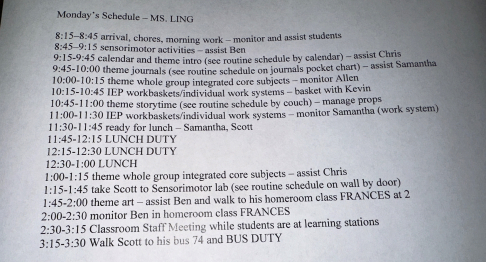
Paraprofessional Monday schedule. Shannon Beyer-Kaminski, 2023
This staff schedule outlines each individual’s responsibilities throughout the day.
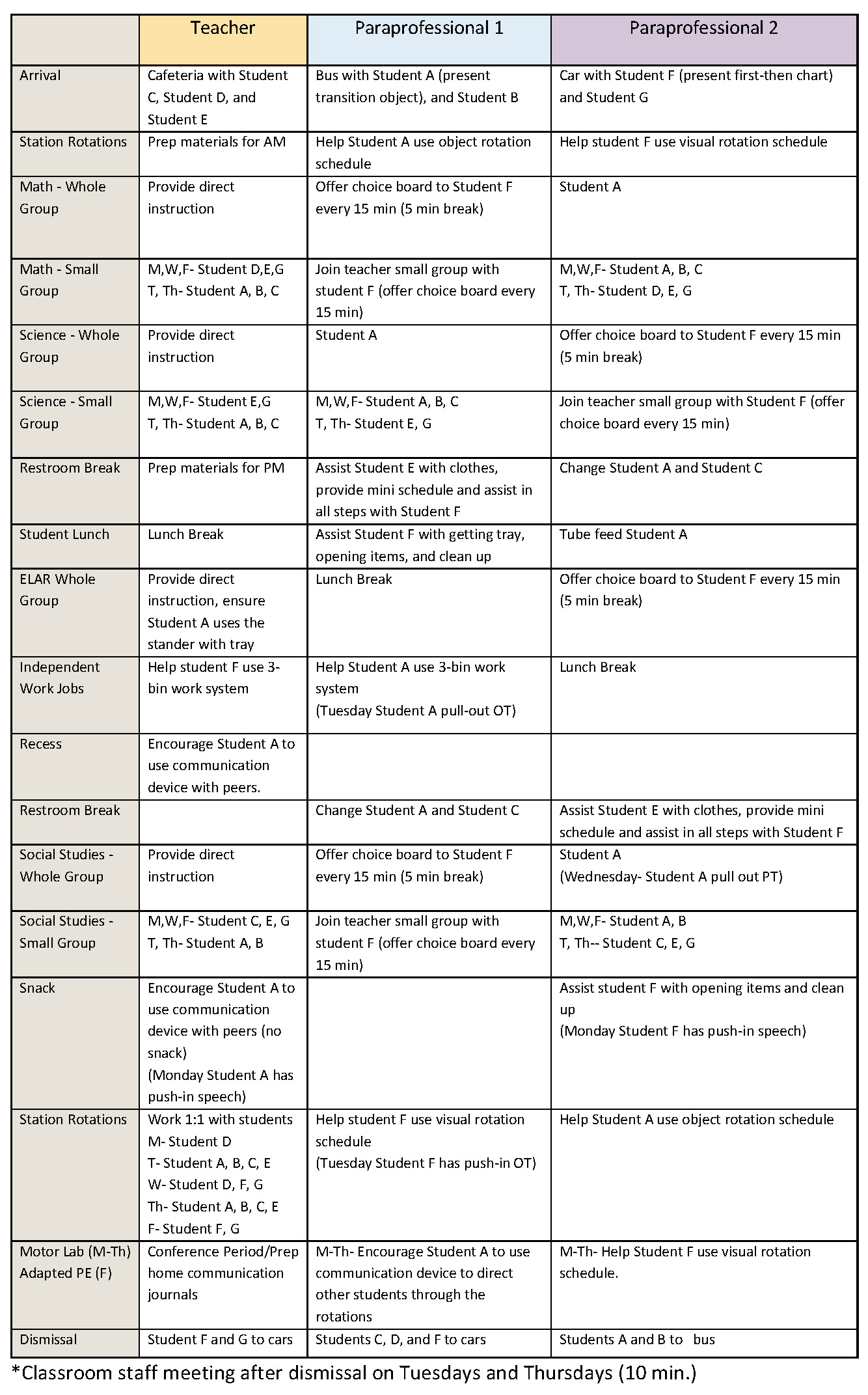
This sample shows the same schedule but is organized by students instead of staff. This may be useful for tracking the location of students or when building their individual visual schedules.
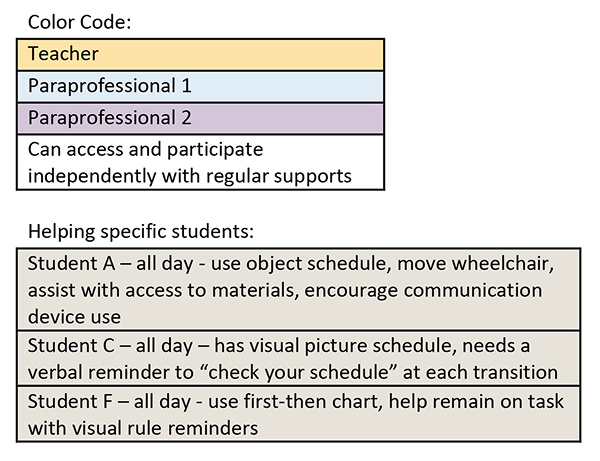
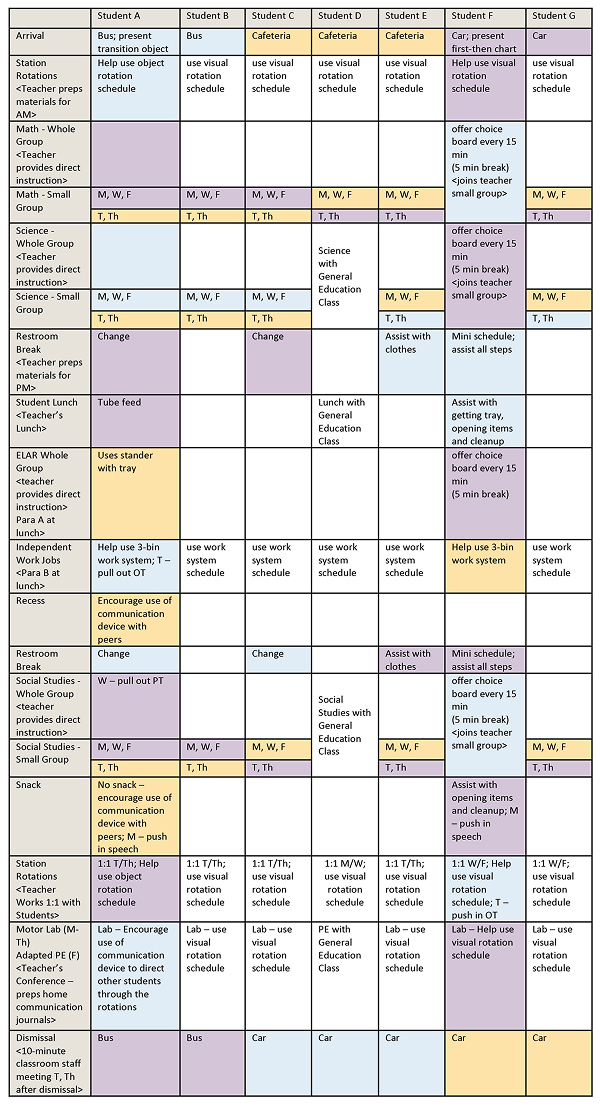
Routines and Procedures
Routines are things that happen repeatedly in the classroom, and procedures are the steps of those routines. Like schedules, routines and procedures help both students and staff understand the expectations.
For example, for the routine of independent work time the procedure might be:
- The student will move to the independent work station.
- The student will look at their system visual support.
- The student will match the 1 on their visual to the docking space on Task Box 1.
- The student will complete the item in Task Box 1 and place it in the finished box.
- The student will look at their system visual support.
- The student will match the 2 on their visual to the docking space on Task Box 2.
- The student will complete the item in Task Box 2 and place it in the finished box.
- The student will look at their system visual support.
- The student will match the 3 on their visual to the docking space on Task Box 3.
- The student will complete the item in Task Box 3 and place it in the finished box.
- The student will choose their break activity from the choice board and transition to that area of the classroom.

Break time choice board. Shannon Beyer-Kaminski, 2023; Work system visual. Shannon Beyer-Kaminski, 2023
Consider setting up routines and procedures for common activities such as:
- Arrival
- Morning Meeting
- Restroom Breaks
- Transitions
- Snack time
- Fire Drills
- Stations
- Data Collection
- Family Communication
Writing rules, creating schedules, and setting up routines and procedures is only part of the job. The bulk of the work is teaching the students the expectations and how to use the schedule tools. This is done through staff direct teaching, modeling, and consistency. Students will need repetition and frequent practice.

Significant Cognitive Disabilities, Instruction
Teaching Routines and Procedures
Write a Classroom Manual
Write a classroom manual to keep all staff consistent with classroom expectations. A classroom manual is a folder, binder, or electronic document that contains important information about how the classroom runs. The manual may include, but is not limited to:
- the classroom philosophy,
- strategies commonly used for supporting students,
- routines and procedures used in the classroom,
- schedules,
- classroom expectations, and/or
- data forms.

Significant Cognitive Disabilities, Instruction
Classroom Manual
When creating your classroom manual, consider writing the resource with the mindset of presuming competence of all learners. As the teacher, you must believe in your students and their ability to learn – no matter the disability or the degree to which the disability impacts the child. It is imperative that you and your staff always presume competence and seek ways to connect with and engage the students. It is an essential part of your job to help every student make connections and gain meaning from the world. This is one of the most critical components of instruction.
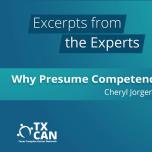
Significant Cognitive Disabilities, Inclusion
Importance of Presuming Competence for Students with Complex Access Needs and the Least Dangerous Assumption
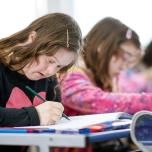
Significant Cognitive Disabilities, Inclusion
Presuming Competence for Students with Complex Access Needs
You may be new to supervising other adults and unsure about doling out responsibilities to others in your classroom. Texas SPED Support has the Working With Paraprofessionals document and the Field User Guide to assist you in understanding the roles of paraprofessionals and the importance of clear communication between members of the classroom team.

State Guidance
Working with Paraprofessionals

Inclusion, ARD/IEP Supports, Instruction
Working With Paraprofessionals Field User Guide
Classroom Manual Excerpts
- Feeding of students - Staff should wash their hands before the preparation of students’ food and avoid touching food as much as possible. Knives, forks, and the food processor can be used to dice and chop as necessary but must be immediately put away afterwards in the locked cabinet next to the sink for safety. Each student’s food is prepared according to the family’s instructions (see student-specific procedures in the back of this manual).
- Changing of students – Our students are each changed 2 – 3 times a day (see student-specific procedures in the back of this manual). Gloves must be worn, and hands washed after each change. All materials are on the changing station area shelves, arranged in student bins, along with the data charts for recording information about each change. Please note in the data chart if a student’s supplies are running low.
- Confidentiality - Personal information regarding a student and their family will not be shared with anyone outside of the student’s support team. This includes IEPs, BIPs, medical records and protocols, behavioral records, grades, data charts, etc. IEPs and other documents with personally identifying information are kept locked in the top drawer of the filing cabinet. Student data sheets around the room are identified by their classroom student number, and not their names. There should be no open discussion of our students in front of other students or in hallways or other common areas. If anyone should ask a question regarding our students, the response should be, “Because of confidentiality laws, I cannot answer that question.” Substitutes in our classroom should only be advised of their responsibilities and student information will only be shared when necessary to complete their job duties.
- Family communication - Families will only be contacted when necessary, and then only by Mr. Stable as the teacher, the nurse, or other staff designated by the principal. If other classroom staff have contact with a family member (such as in the morning when they are dropping off the student), such contact should be brief and general. Any questions from the family should be referred to Mr. Stable. Likewise, if a family member is seen outside of school, conversation should be of a brief, social nature. If they have specific questions or concerns, they should be prompted to set up a teacher conference.
- Student A – PE – After he checks his visual schedule, allow him to walk to his homeroom class to join the line for PE. Remain about one classroom length behind the student to encourage independence, using verbal prompts only if needed. He should remain in line with his peers as they walk to the gym. When entering the gym, he should locate his spot and sit down to wait for instructions. Supervise the student from the side of the room nearest his row. If the student requires redirection during the instruction/activity, call his name and show him the visual support for the rule he should follow. Record the number of times he needs redirection in his folder. After PE, he will line up with his peers and walk with them to lunch independently.
- Student B – Building Communication – During classroom activities, give her a choice of materials to use in the activity (e.g., different types of counters for math, different color paints for art, different books for reading). Have a third item available out of view. Present the real-item choices of two options and a universal no symbol by placing them on her tray as you name them. Ask, “Student B, what do you want?” Let her choose by pointing at an item or the symbol.
- If she points toward an item, remove the other items from her tray.
- Allow one minute of wait time, and if she does not make a choice, respond, “I didn’t understand what you wanted, let’s try the (you choose an item).” Remove the other items from her tray.
- If she points toward the universal no symbol, say, “OK, you don’t want either of these. Let’s use (third hidden item) instead.” Place the third item on her tray. Mark the results of the trial on her communication data sheet.
Extend Your Learning
Learn more about Quality Indicator II: Effective Teams and Quality Indicator III: Classroom Climate in the free online courses Teamwork and Transitions and Classroom Organization, Schedules, and Positive Behavior Supports.

Significant Cognitive Disabilities
Teamwork and Transitions

Significant Cognitive Disabilities
Classroom Organization, Schedules, and Positive Behavior Supports
Final Thought: Be consistent
This month, set up the framework for the school year by organizing your classroom and creating structure with rules, schedules, routines, and procedures. As you move through September, you will continue to teach, practice, and refine your procedures. Be consistent so that the expectations for your students and other classroom staff are clear.
Looking Ahead
As important as classroom systems are, learning these can be overwhelming for students. They will need the support and guidance of your staff. At the beginning of the year, as you practice moving through the school day with your students, start with activities with minimal cognitive demands. Concentrate on learning the schedule, practicing transitions between activities, clarifying steps of procedures, and pairing yourself with positive experiences and items to build rapport with your students. You can find more information about building relationships in the September Monthly Instructional Guide.
